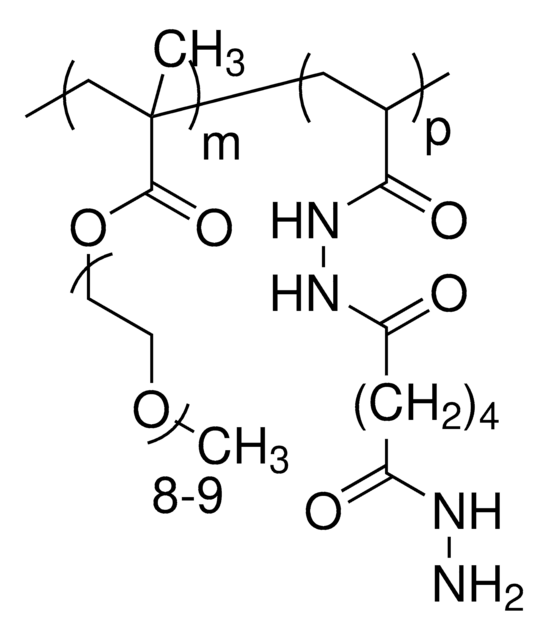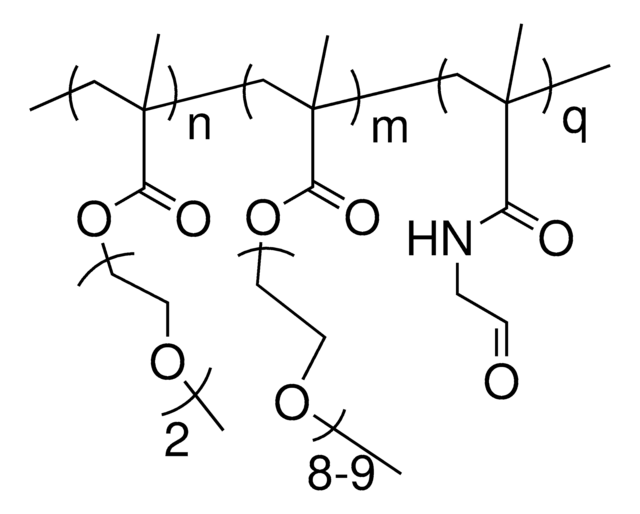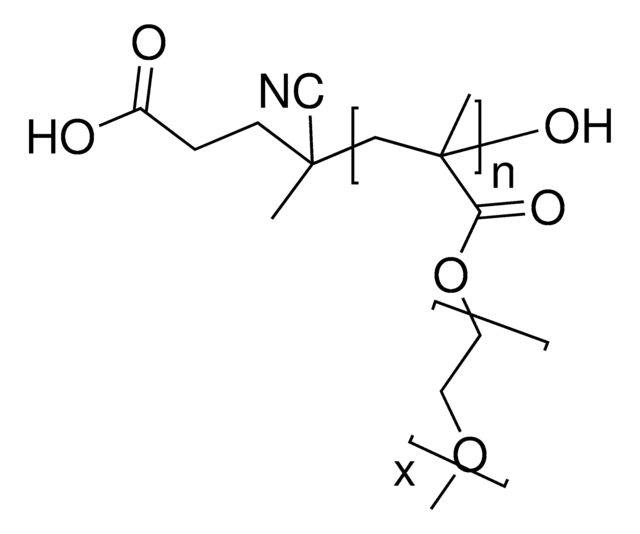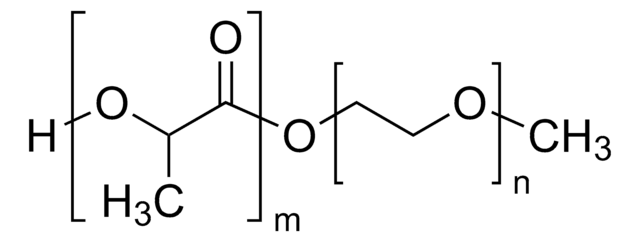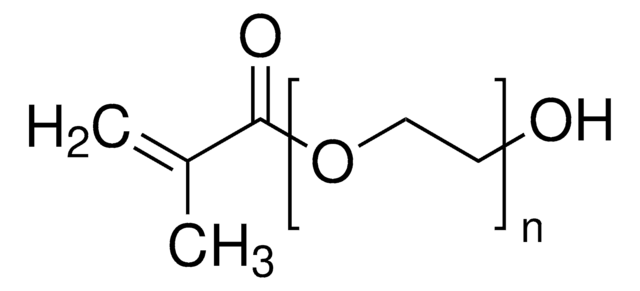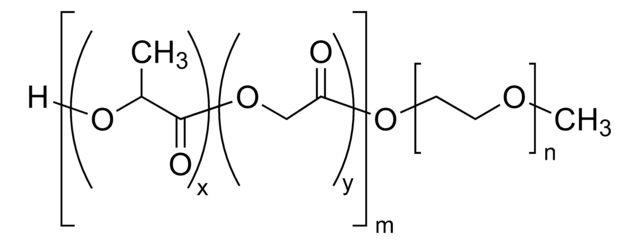901546
Poly(M(EO)2MA:Poly(OEGMA) 90:10
hydrazide functionalized, 25 wt. % (solution in water)
Sinónimos:
PEGMA-co-POEGMA
Iniciar sesiónpara Ver la Fijación de precios por contrato y de la organización
About This Item
Fórmula lineal:
[CH2CCH3(COO(CH2CH2O)2CH3)]p[CH2CCH3(COO(CH2CH2O)8CH3)]n[CH2CHCONHNHCO(CH2)4CONHNH2]m
UNSPSC Code:
12162002
NACRES:
NA.23
Productos recomendados
form
solution
mol wt
Mw ~20,000 g/mol
concentration
25 wt. % (solution in water)
color
clear colorless to pale yellow
functional group
hydrazide
storage temp.
2-8°C
Categorías relacionadas
Application
In addition, the physical properties of the resulting hydrogels, such as LCST, gelation rates, swelling kinetics, degradation kinetics, and mechanical properties, can all be readily controlled by solution concentration and the ratios of each solution.
This product is provided as a 25 wt% solution in water, ready to be diluted for your specific application. Please see the technical bulletin on the product page for dilution instructions and hydrogel preparation instructions.
This product is provided as a 25 wt% solution in water, ready to be diluted for your specific application. Please see the technical bulletin on the product page for dilution instructions and hydrogel preparation instructions.
Poly(diethylene glycol methacrylate)-co-(oligoethylene glycol methacrylate), (PM(EO)2MA-co-OEGMA) is a comb-shaped, graft copolymer consisting of hydrophilic oligomer polyethylene glycol (PEG) chains grafted to a hydrophobic polymethacrylate backbone. In this material, the PEG chains are either diethylene glycol units or oligomer PEG (n=8-9) units. Resulting material properties can be tuned by controlling the ratio of each component. POEGMA has been suggested as a viable alternative to PEG in biological and biomaterial applications. POEGMA has been reported to improve pharmacokinetic properties of protein and peptide conjugates, enhance the stability and gene silencing efficiency of siRNAs, as an anti-fouling surface for biosensors, and eliminate PEG antigenicity. In addition to use in biomolecule-polymer conjugates, PEOGMA has also seen wide spread use in tissue engineering applications, such as hydrogel synthesis. Hydrazide-functionalized PM(EO)2MA-co-OEGMA can be readily used with the corresponding aldehyde-functionalized POEGMA or PM(EO)2MA-co-OEGMA for rapid gelation via reversible hydrazone bond formation. Due to the reversibility of the bond formation and the low viscosity of the precursors, resulting hydrogels can be used as injectable tissue engineering matrices, local drug delivery vehicles for small molecules, or as joint lubricants.
Storage Class
10 - Combustible liquids
wgk_germany
WGK 3
flash_point_f
Not applicable
flash_point_c
Not applicable
Elija entre una de las versiones más recientes:
Certificados de análisis (COA)
Lot/Batch Number
¿No ve la versión correcta?
Si necesita una versión concreta, puede buscar un certificado específico por el número de lote.
¿Ya tiene este producto?
Encuentre la documentación para los productos que ha comprado recientemente en la Biblioteca de documentos.
Reactive electrospinning of degradable poly(oligoethylene glycol methacrylate)-based nanofibrous hydrogel networks.
Xu F, et al.
Chemical Communications (Cambridge, England), 52, 1451-1454 (2016)
A brush-polymer/exendin-4 conjugate reduces blood glucose levels for up to five days and eliminates poly(ethylene glycol) antigenicity.
Qi Y, et al.
Nature Biomedical Engineering, 1, 0002-0002 (2016)
Imran Ozer et al.
Biomacromolecules, 18(9), 2699-2710 (2017-08-05)
PEGylation, covalent attachment of PEG to therapeutic biomolecules, in which suboptimal pharmacokinetic profiles limiting their therapeutic utility are of concern, is a widely applied technology. However, this technology has been challenged by reduced bioactivity of biomolecules upon PEGylation and immunogenicity
Karthikeyan Gunasekaran et al.
Macromolecular rapid communications, 32(8), 654-659 (2011-04-12)
A thiol-modified siRNA targeting the enhanced green fluorescence protein (eGFP) gene was conjugated with RAFT-synthesized, pyridyl disulfide-functional poly(PEG methyl ether acrylate)s (p(PEGA)s). siRNA-p(PEGA) conjugates demonstrated significantly enhanced in vitro serum stability and nuclease resistance compared to the unmodified and thiol-modified
Fei Xu et al.
Chemical communications (Cambridge, England), 52(7), 1451-1454 (2015-12-10)
A direct, all-aqueous electrospinning method for fabricating degradable nanofibrous hydrogel networks is reported in which hydrazide and aldehyde-functionalized poly(oligoethylene glycol methacrylate) (POEGMA) polymers are simultaneously electrospun and cross-linked. The resulting networks are spatially well-defined, mechanically stable (both dry and wet)
Nuestro equipo de científicos tiene experiencia en todas las áreas de investigación: Ciencias de la vida, Ciencia de los materiales, Síntesis química, Cromatografía, Analítica y muchas otras.
Póngase en contacto con el Servicio técnico